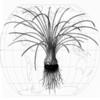| Publication Type: | Journal Article |
| Year of Publication: | 1998 |
| Authors: | M. Holmer, Jensen, H. S., Christensen, K. K., Wigand, C., Andersen, F. O. |
| Journal: | Aquatic Botany |
| Volume: | 60 |
| Issue: | 4 |
| Pagination: | 307 - 324 |
| Date Published: | 1998/// |
| Keywords: | Dissolved organic carbon, Freshwater, Submerged macrophytes, Sulfate reduction, Sulfur pools |
| Abstract: | Sulfur cycling was examined in sediments inhabited with the isoetids Littorella uniflora and Isoetes lacustris in the oligotrophic soft-water Lake Kalgaard, Denmark. Based on short-term tracer incubations sulfate reduction was measured along a transect from the shore (0.6 m) to profundal sediments (4.6 m). The sulfate reduction rates were low (0.008-0.8 mmol m-2 d-1) in the sandy shallow sediments with low organic content (< 1.3 mmol C g-1 sed DW) and high redox potentials (> 100 mV), whereas sulfate reduction was higher at the deeper sites (2.7-4.6 mmol m-2 d-1) with high organic content (max. 11.5 mmol C g-1 sed DW) and lower redox potentials (< 100 mV). High concentrations of dissolved organic carbon (DOC) were found in the low particulate organic sediments (up to 18.4 mM), and most of the DOC pool consisted of acetate (40-77%). Reoxidation of sulfides due to root oxygen release was probably important at all sites and a positive efflux of sulfate across the sediment-water interface was measured, attaining rates (up to 4.8 mmol m-2 d-1) similar to the sulfate reduction rates. Reoxidation of sulfides was also manifested by high fraction (> 80%) of reduced sulfides being accumulated as elemental sulfur or pyrite (chromium reducible sulfur, CRS). The largest pools of CRS were found in high organic sediment with vertical distributions resembling those of the sulfate reduction rates. The overall effect of isoetid growth on sulfur cycling in the rhizosphere is a suppression of sulfate reduction in low organic sediments and the governing of sulfide reoxictation in sediments with higher organic content. |
| URL: | http://www.scopus.com/inward/record.url?eid=2-s2.0-0032051759&partnerID=40&md5=cedb9f2713f49909e7234473be0de561 |
